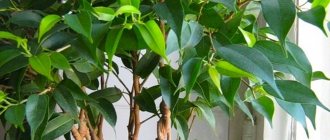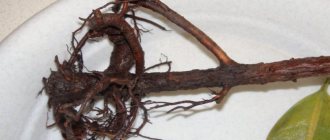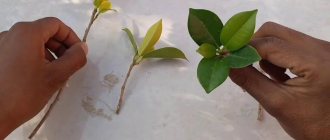Ficus benjamina is a beautiful and elegant plant, very popular among gardeners. Thanks to the dense crown, the flower can be used to form either a small tree or a bush, or grow a miniature bonsai. In the article we will look at the features of pruning Ficus Benjamin, find out whether it is necessary to prune, how to carry out the procedure correctly, and many other subtleties and nuances.
general information
Ficus benjamina has its own characteristics of growth and development. To properly perform pruning, you need to become familiar with these features.
Branches of a new order grow in this case from shoots, while shoots are formed from buds located on the main branches and trunk. Ficus Benjamin has two different types of buds:
- apical, responsible for the growth of the flower upward and located on top of the trunk;
- lateral, responsible for the growth of the crown in breadth and located along the trunk along its entire length.
The top bud has the fastest growth: if it is removed, the lateral buds begin to grow rapidly to compensate. If the goal is to get a lush crown, the top bud should be removed in the spring - when the most active growth is observed.
It is better not to model the crown in autumn and winter, since during this dormant period the crown may turn out to be one-sided and ugly. In addition, it is possible to simulate a neat crown of the desired shape only if the ficus is still young. When the plant is fully formed, it will not tolerate traumatic pruning well. Ideally, you need to complete all basic formation procedures before the ficus reaches the age of three years.
How to prune ficus benjamina to form a trunk
You can get a beautiful tree from a ficus by forming a trunk. To do this, plant one cutting in a pot and leave it to “grow” in height. Any side branches that appear at the bottom of the plant should be removed until the trunk reaches the desired height. Only the topmost branches are left for the crown, at the top of the ficus, and in quantities of no more than 5 pieces.
For a mini-tree that can be placed on a cabinet, the height of the trunk is 20 cm. For floor-standing specimens, you can increase the trunk to 1 m in height.
When the ficus trunk reaches the above values, you can begin to form the crown. The technique is the same as for the bush form: cut off or pinch the tops of the shoots, stimulating their branching. Moreover, if the ficus decides to grow a branch in the lower part, on the trunk, it must be removed.
The shape of the crown itself can be made in the form of any geometric figure, periodically cutting off shoots that grow beyond its limits. A multi-tiered trunk also looks original when, after forming the first crown, a second trunk is left and grown on the central shoot.
Is pruning necessary?
When growing Ficus Benjamin, you need to prepare in advance for its upcoming pruning - the procedure will have to be carried out regularly. If you do not trim the plant, you can end up with an ugly, sloppy specimen that will not decorate, but, on the contrary, will spoil the interior with its appearance.
In addition to solving the problem of decorativeness, pruning has other, equally important tasks. For example, sanitary pruning rids the ficus of protruding, dried, diseased branches, which can become a source of infection for the plant. Anti-aging pruning solves the problem of flower aging, rids it of outdated shoots, gives new strength, and activates growth and development.
As for formative pruning, today it has become a kind of art. You can grow this flower as a small tree, bonsai, or make a compact bush out of it. If you have some experience, you can even “braid” the shoots of the plant into a kind of braid or spiral, giving the ficus a bizarre, original look. Particularly talented flower growers are able to form the crown of a plant in the form of sculptures - figures of animals, people, geometric shapes.
However, it is better to entrust complex formative pruning to specialists, professionals in this field. If an inexperienced person begins to form a complex ficus crown, without knowing all the subtleties, this undertaking may end in complete failure.
However, sanitary pruning and simple crown formation can be performed by any gardener independently, without the involvement of third-party specialists. Broken, damaged shoots and branches growing inside the crown will still have to be removed. And you shouldn’t let the ficus grow too much, otherwise the flower can turn into a real giant.
Tiered standard - what is it like?
A tiered trunk is a tree that has not one, but two crowns, separated by a void of several centimeters. Such a tree, depending on its height, may even have more than two, and sometimes three, tiers.
Usually it all starts with one crown of ficus Benjamin, and after that the tree is pruned so that the central shoot grows, which will be directed upward. Thanks to it, it will be possible to create a continuation of the trunk, and, consequently, another tier. Gardeners note that this process is long and quite painstaking.
As for the tiered trunk, created from one cutting, it is formed as follows:
- First, one cutting is selected, growing upward and forming a tall trunk.
- After the lower part of the trunk is formed (all shoots are removed), it will be necessary to divide the crown into three equal parts. The upper and lower parts will make up the crown, and the middle will act as a bare trunk.
- After division in the center, the side shoots are removed. As for the top of the trunk, it is pinched. Everything else is done according to the same scenario as in the case of creating a regular standard.
Experienced gardeners recommend planting two cuttings in a pot at the same time, the trunks of which will need to be fastened with wire. Over time, the bases will grow together at the bottom and separate at the top. Taking into account the different sizes of plants, it will be possible to create trunks that will look like tiers.
When and how to prune
We will find out at what time to carry out the procedure and what tools and devices will be needed for it.
Time
Formative pruning of Ficus Benjamin should be carried out annually in early spring. The optimal time for this is the end of March - beginning of April. The choice of this period is not accidental: after early spring pruning, the ficus, thanks to the active growth that has begun, will be able to recover and recover much faster.
Sanitary shortening can be carried out at any time of the year when the need arises.
However, it is still undesirable to prune the plant in autumn and winter. A traumatic procedure during this period leads to a strong and rapid consumption of nutrients accumulated over the summer.
Tools
Prepare the following equipment before the procedure:
- pruner;
- charcoal - charcoal or activated;
- napkin;
- antiseptic - potassium permanganate or alcohol;
Disinfect the cutting tool to prevent infection from entering the plant tissue. Wear long rubberized gloves and protect your face from splashes of milky juice - it is poisonous in ficus and causes irritation if it comes into contact with the skin.
Sculpture - how to create a real masterpiece
In order to create a sculpture, it is important to know not only how to trim the ficus correctly, but also how often this should be done. It must be said right away that creating a sculpture in the form of a bird, flower or the like is a very difficult task that only a good sculptor or designer can handle. In this case, it is necessary to both perform a series of actions aimed at trimming unnecessary shoots, and also have imagination in order to create an exact copy of what was thought up in advance. There will be little ordinary knowledge on the formation of the crown of Ficus Benjamin.
True, you can work hard to create a plant in the form of a cylinder, cone or snake. In this case, it is important to trim the flower so that it acquires the desired shape. In one case, you will need to remove the top shoots, in the other - the side or bottom shoots according to the principle as described above. It should be said that pruning and shaping can take more than one year before the grower gets what he needs.
Very often, to give the trunk an unusual shape, gardeners come up with tricks: they plant several cuttings, which are then woven into a braid; they install a frame for the desired bend and more. If you also use special pruning of the Benjamin ficus, you can end up with an original decorative flower.
Pruning rules
Let's take a closer look at all the intricacies of the ficus Benjamina pruning procedure.
It is better not to carry out two types of traumatic procedures at the same time, as this will greatly weaken the plant. For example, you cannot immediately trim the plant and immediately replant it. Leave a period of at least two weeks between these procedures. If the ficus is sick, weakened, or recovering its health at this time, cutting should also be postponed.
Before the procedure, clean the ficus from dirt, remove dust from its leaves and shoots. This will protect the plant from possible infection in the wounds.
The main trunk is shortened only once a year and no more than 30 cm. Cuts must be made above the buds to allow the ficus to grow in width and send out side shoots. After the procedure, at least 5 leaves should remain on the shortened shoot. If aerial roots are encountered along the way, they are not cut off, but directed into the soil.
Young shoots need to be cut horizontally; old branches need to be cut obliquely. Immediately disinfect the cut areas to prevent any chance of infection spreading. For the purpose of disinfection, you need to wipe the sections with a napkin and sprinkle with charcoal.
Stumps at the cutting site are unacceptable, as they spoil the overall appearance of the plant. Trim branches evenly. Note that in addition to the spoiled appearance, fungal spores and various bacteria also accumulate in the stumps.
Feed the plant after pruning so that the ficus recovers and recovers faster.
Which ficus trees do not need pinching?
A big problem with all ficuses is the loss of their decorative appearance due to the falling of the lower leaves. Even if a plant is genetically programmed to branch, the branches and trunk gradually become bald. In addition, tree shoots often grow in random order, interfere with each other, hang down, and create shadows. Without formative procedures, even a beautiful plant in a few years risks turning into something painful and unattractive.
Pinching and pruning are recommended for all types of ficus.
Types of pruning
Ficus benjamina needs three main types of pruning:
- formative;
- sanitary;
- rejuvenating.
Let's get acquainted with these types in more detail.
Sanitary pruning
The procedure can be carried out not only in spring, but also at any other time of the year, if necessary. The purpose of sanitary pruning at home is to rid the plant of unnecessary load: weak, diseased, damaged branches, as well as shoots that thicken the crown. Dry branches must be removed as they spoil the appearance of the plant and are a source of infection.
If the plant is sick, a fungal or other infection has occurred, sanitary pruning is carried out immediately. In this case, it is necessary to remove all affected parts of the plant to prevent further spread of the infection.
You should also remove weakly growing and poorly developed shoots in a timely manner, since they are of little use or beauty, and they take away nutrition from the plant and quality shoots. Branches growing inward should also be removed, since they create shadow in the crown, thicken it, and create favorable conditions for the spread of fungus.
Rejuvenating
This type of pruning is carried out in relation to adult plants: young ficus does not need even more rejuvenation. With age, the shoots dry out, become ugly, and grow poorly. Anti-aging pruning helps the ficus “shake up”, gives it new strength, and activates development. The time recommended for this procedure is early spring, preferably before active sap flow begins.
During rejuvenating pruning, all old, dried branches should be removed, and living shoots should be shortened by half. If the crown is very dry, rejuvenating pruning of it “under the stump” is permissible, that is, almost completely. The stump remaining after the procedure should be 7-10 cm in height, not higher. Gradually, the ficus will again grow a new crown, becoming even more beautiful.
Formative
A necessary procedure to maintain the attractive appearance of the plant and limit its growth. During formative pruning, all thick branches are shortened - cuts are made obliquely and directly above the bud. Thin shoots are cut straight to about a third of their length. The cut areas must be treated immediately: wipe off the milky juice and sprinkle with charcoal.
Preparation for the procedure
Before carrying out the procedure, it is worth remembering the following factors:
- It is best to form a crown at home of the required size and diameter before the age of 3 years. It is up to this moment that the plant actively grows and develops. At a later time, it will be more difficult to give the desired shape and the recovery process will be more difficult;
- Ficus benjamina is best pruned when the plant is strong and healthy. If disease or pests appear, it is better to postpone the procedure until a better time.
Instructions for the procedure
In order to properly prune a plant you need to:
- Prepare the ficus for the procedure (water, clean from dust);
- Prepare a garden tool (secateurs) or sharp scissors and clean it thoroughly;
- Cut thin branches straight, thick ones obliquely;
- After the cut, it is necessary to carry out a disinfection procedure, namely, sprinkle the area with pre-prepared wood ash. Before doing this, wipe off any juice that appears at the cut site with a clean rag;
- During the procedure, try to make the shape as natural as possible;
- Before pruning a branch, you can and should imagine the end result each time, in other words, “measure seven times...”;
- First of all, you need to remove those branches that have become very thick and spoil the appearance of the entire ficus;
- Branches that intertwine and grow parallel to the main trunk should also be pruned;
- To shorten, we remove the top shoots and branches; to thin out and reduce density, we cut off the side shoots.
Types of crowns
Let's get acquainted with the most popular types of crowns of Ficus Benjamin and learn the features of their formation.
Bush
To form a bush from a plant, both a tall Benjamin ficus and a short one are suitable. If you take a small-leaved variety, you can get a particularly lush bush.
In order for such a bush to form, at least two or three ficus cuttings must initially be planted in the pot. When the cuttings take root and begin to grow, pinch off their tops at a height of 15 cm. Then pinching continues on the already growing side shoots. In this way, active branching begins, which ultimately leads to the formation of a neat bush.
Stamb
Ficus Benjamin of the standard type is, in fact, a small tree with a pronounced trunk (see photo). In order for a high-quality standard to form and grow beautifully, only one cutting must initially be planted in the pot. As the cutting grows, its lower side shoots are removed, and a few upper ones are left. In this way, a clear silhouette of the tree is gradually formed - with a trunk and a spreading crown.
If the goal is to get a half-meter plant, the trunk length is left at 15-20 cm, the rest will be the crown. These miniature trees are intended for growing on tables, stands, and window sills. If the ficus is planned to be placed on the floor, it is made taller, forming a trunk of 40-50 cm and a crown of approximately the same size.
To prevent the trunk from falling to one side during the formation of the trunk, it is recommended to support it with a peg. The support is removed when the trunk grows strong and thick enough to support the crown on its own.
Tip: turn the plant from time to time with different sides to the sun so that the crown is even and without distortions.
Tiered standard
This is also a standard type with a pronounced trunk, but the crown in this case is not solid, but consists of several tiers. An interesting feature is that a bare trunk should be visible between the tiers of the crown. Usually they make two tiers, but sometimes three.
The build-up of tiers can occur gradually: first the lower, then the upper. However, knowledgeable flower growers plant two cuttings in a pot, fastening their trunks with wire - and form a crown from the resulting structure. Over time, the trunks of the fastened cuttings grow together at the bottom, and their crowns at the top become separated.
In this way, you can grow a trunk from two different types of ficus - with different leaf colors. In this case, the appearance of the plant will be especially decorative and original.
Bonsai
The plant can be used to form a miniature bonsai, popular in Japan. To get such an original flower, you must initially plant the cuttings in a wide and low pot with infertile soil - the ficus will not be able to grow quickly in such conditions.
To obtain a bonsai, pruning the roots is also important - they need to be trimmed 2-3 times a year. After root pruning, each time the plant is planted back in the same container.
You also need to correctly form the trunk and crown. For this purpose, the branches and trunk are wrapped with copper wire, gradually bending it. The entire formation procedure usually takes 4-5 years, after which the ficus will already look like a real bonsai.
Sculpture
Forming a crown in the shape of an original sculpture is a task for experienced gardeners. The work is quite painstaking and time-consuming, even if we are talking about a simple geometric figure. If you want to get a sculpture of a bird, animal or person, it is best to contact a specialist.
You can grow a ficus in the form of a cone or cylinder yourself - such shapes are the simplest. However, it is necessary to take into account that the formation of the crown will take more than one year. Every year in the spring you need to prune, adjusting the crown to the selected standard.
Ficus weave
You can not only trim the crown, giving the plant a well-groomed, beautiful appearance, but also engage in ficus weaving, creating a real original work of art. As a rule, tall varieties with bare trunks are selected for weaving.
Unlike other types of formation, in this case the first place is given not to the crown, but to the trunk - or rather, several trunks intertwined with each other. The crown is usually made simple, spherical and compact.
To be able to intertwine the trunks, several cuttings must be planted in a pot at once. All trunks should be approximately the same length and thickness so that none of them overwhelms the others. Side shoots must be removed so that the trunks are bare with a small crown on top.
Young trunks need to be woven in such a way as not to create too tight a space between them. Leave some free space: the ficus will continue to grow.
The most common types of weaving are braid and spiral. They are also the simplest. A spiral is made from two trunks, a pigtail from three. You need to start weaving the figure when the trunks reach a height of 13-15 cm. The next turn is done after some time, when the ficus grows after the previous one. To prevent the braid or spiral from opening back up, tie the trunks with soft woolen threads after the twist.
Creating a bush
Ficus is a tall tree, but this does not mean that it cannot be made into a bush. The peculiarity of creating the presented form is that you need to know how to pinch the ficus and what to do after.
However, first things first:
First you need to decide what variety the bush will be created from. Usually small-leaved plants are used, but other types of ficus can also be used.
Having decided on this, you will need to plant several cuttings close to each other in a pot. When the cutting gives roots and then grows to 15-17 cm, you will need to pinch it on top, leaving about five leaf blades. This procedure will stimulate the growth of side shoots.
Once the side branches reach a length of 12-15 cm, it will be necessary to trim these tops as well.
Important! The upper buds are directed not inward, but outward.
Upon completion of the procedure, the sections are thoroughly wiped with a napkin and then covered with charcoal.
When new shoots appear, you will need to carry out exactly the same procedure with them. These branches will be considered branches of the third level. At this stage, you can already observe a bush of sufficient density. If you notice that there are too many branches, then it is worth thinning out.
When the crown of the bush is formed, the plant itself is placed in an evenly lit area so that the shoots grow equally on all sides. As an option, you can simply rotate the flower regularly, turning one side towards the sun today and the other tomorrow.
Care after pruning
Let's get acquainted with the measures for caring for the Benjamin ficus after pruning it.
Temperature and lighting
It is optimal to grow a flower at a temperature of +13-22 degrees, but in winter keep it away from heating radiators. It is necessary to protect the plant from drafts, of which the ficus is very afraid. A flower can respond to temperature changes by dropping its leaves. Such a symptom indicates an unsuitable place, and you urgently need to move the ficus to another room - where there is no access to drafts.
Keep the plant away from direct sun, which can cause burns and spots on the leaves. In winter, however, direct sun, on the contrary, will come in handy - but for a few hours a day. Especially when it comes to the variegated ficus Benjamin.
Feeding and watering
During the growing season, and especially after pruning, ficus needs adequate nutrition. Use a special complex fertilizer for ficuses or a universal fertilizer.
The flower also needs watering, but not too often. On average, the recommended frequency of moisturizing procedures is once a week. The soil should dry out between waterings. In summer it is permissible to water more often; in winter you can reduce the procedure to once every 10 days.
Spraying is useful for ficus: especially in dry air conditions in the apartment in winter and in the summer heat. Before spraying, make sure that the flower is out of reach of direct sunlight: otherwise burns are likely.
In general, ficus benjamina tolerates pruning quite easily. And even, on the contrary, it usually becomes more active and begins to grow better after it
So, we learned how to properly prune Ficus Benjamin, and what types of pruning exist. Now you know that to give a plant a neat appearance, pruning is simply necessary: without these procedures, you cannot get a high-quality plant that decorates the interior. Fortunately, the pruning procedure is not so complicated - and even an inexperienced gardener can do it if desired.
How to pinch so that it bushes and is lush?
For plants that are too tall, the procedure for forming new side shoots remains relevant. The owner of a ficus can use several methods:
- Japanese method. Suitable for small flowers that do not fit on the windowsill.
- Trimming. If you remove the top of the plant, the ficus will produce new shoots. This will make the flower more magnificent. But it should be borne in mind that if the procedure is performed incorrectly, the ficus will continue to grow upward.
Important! When using the Japanese pinching method, branches can be tied not only to the trunk, but also to pegs specially driven into the ground.











